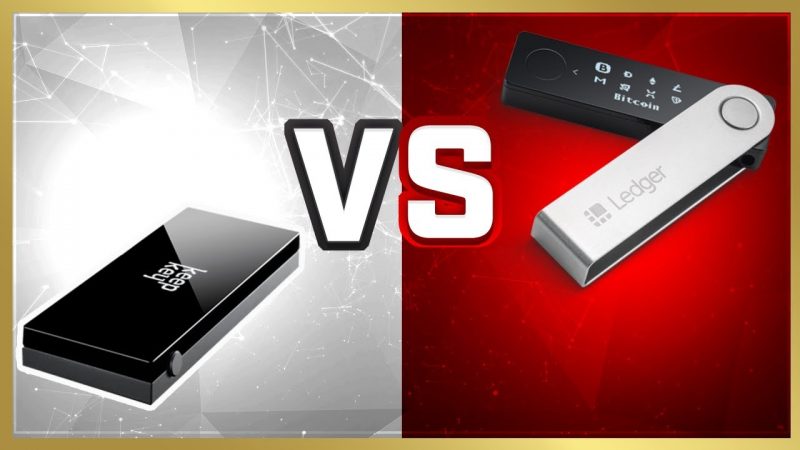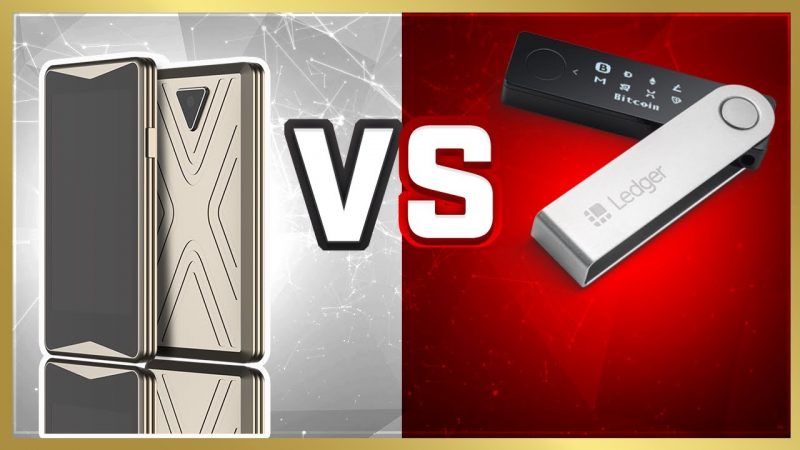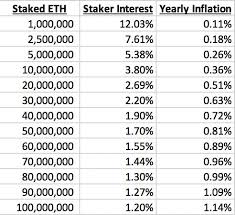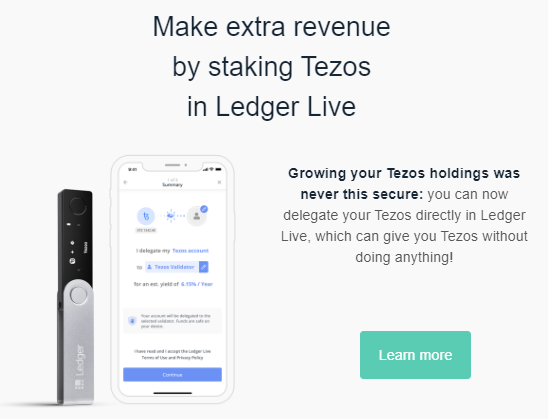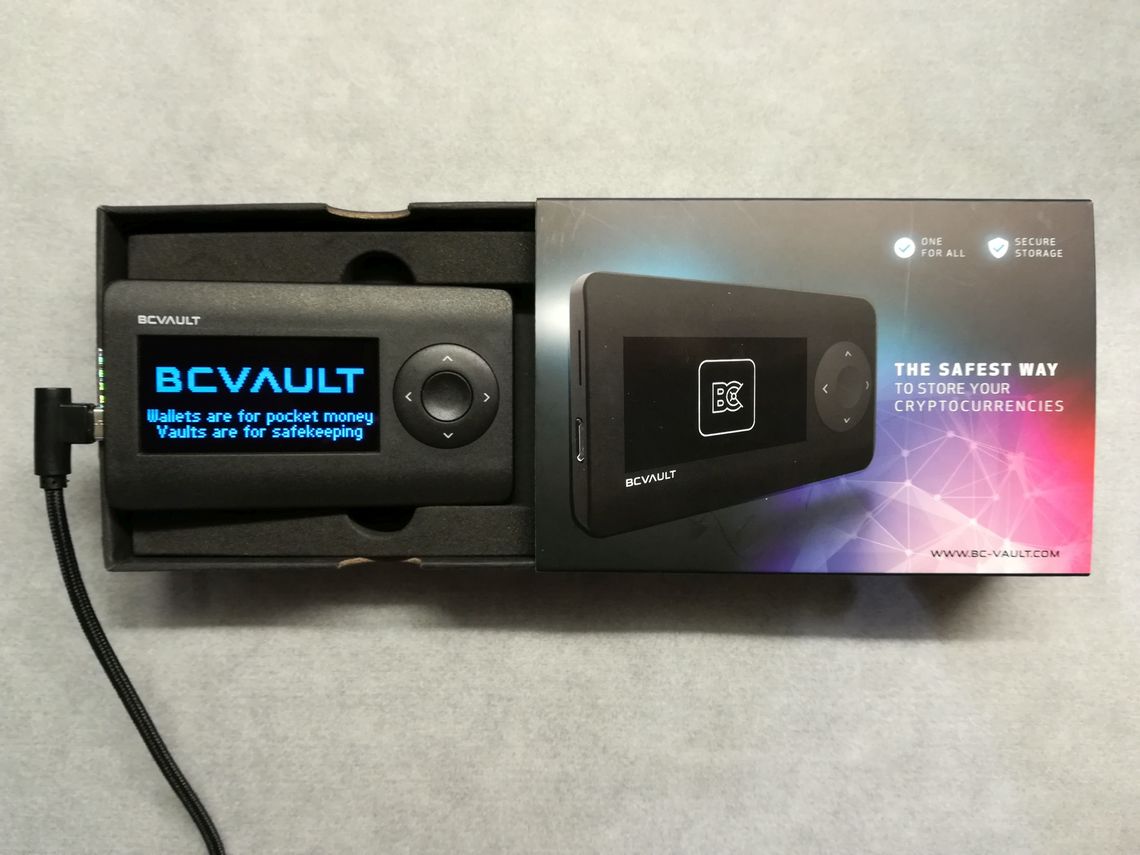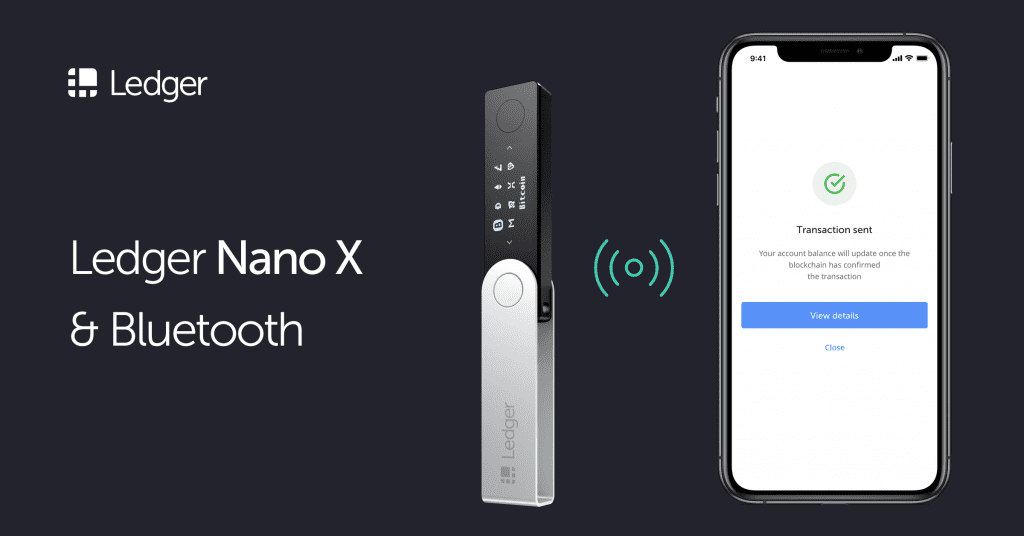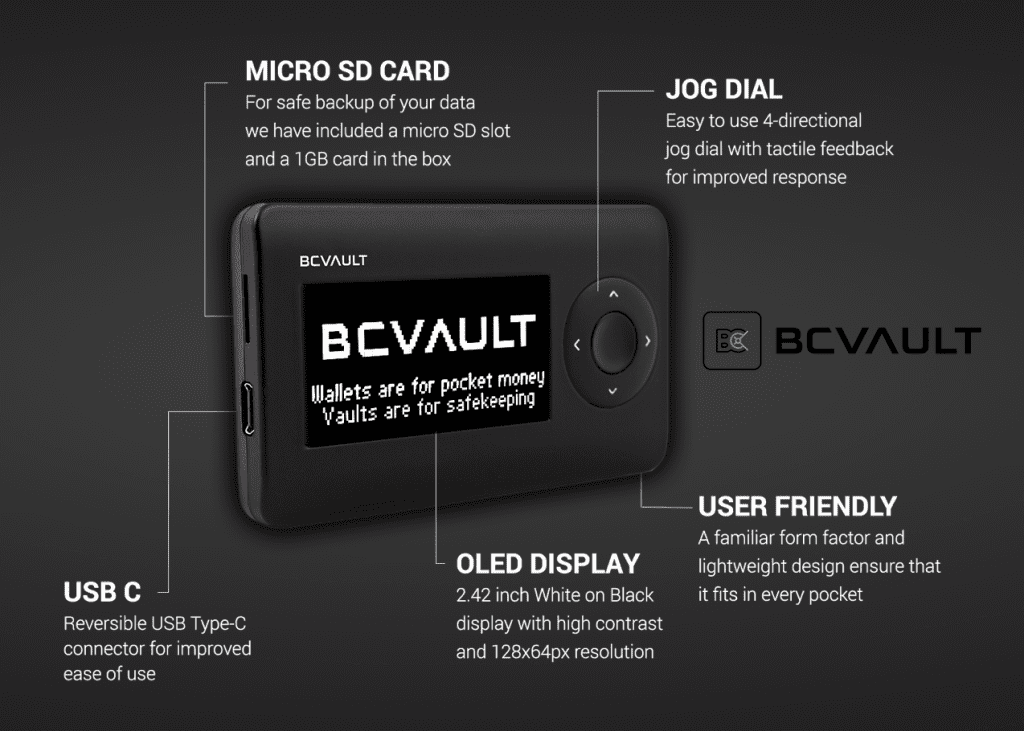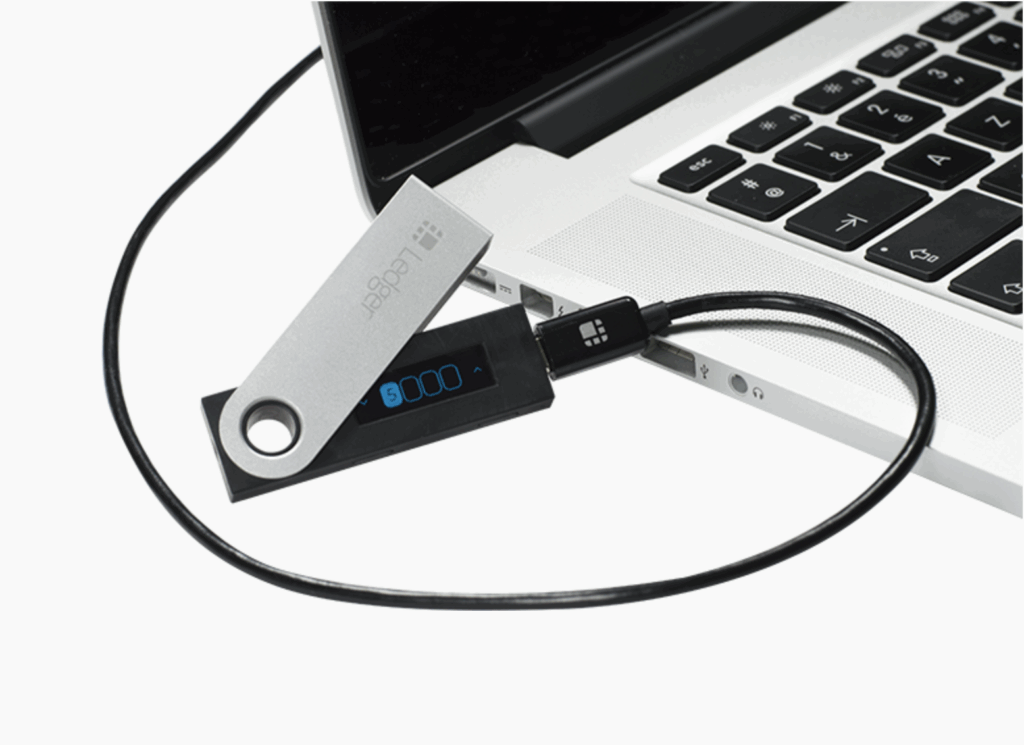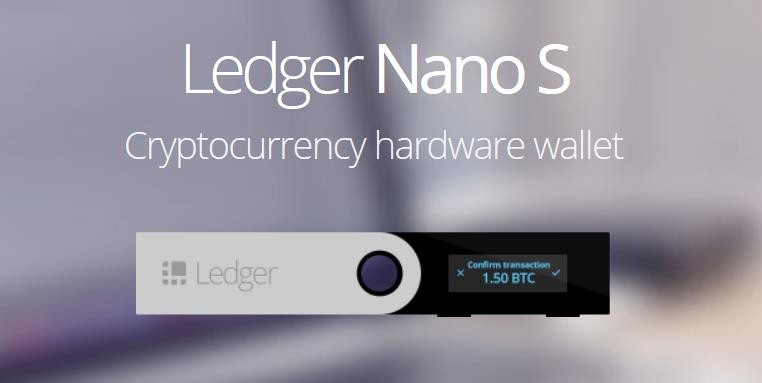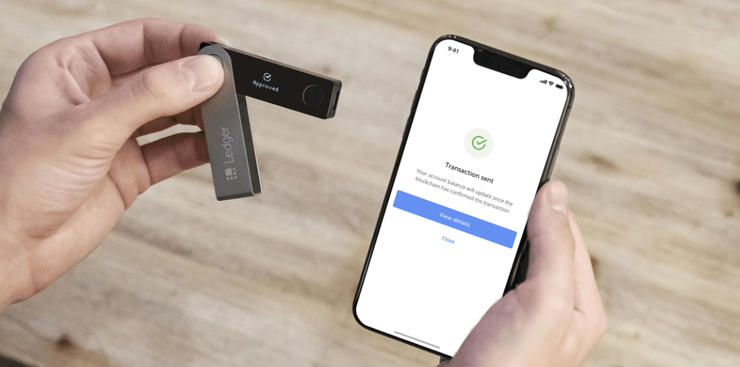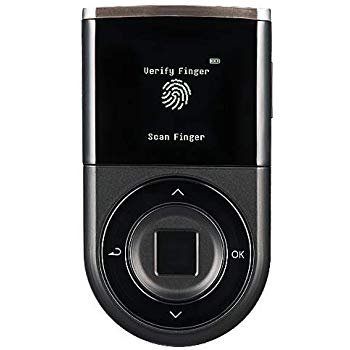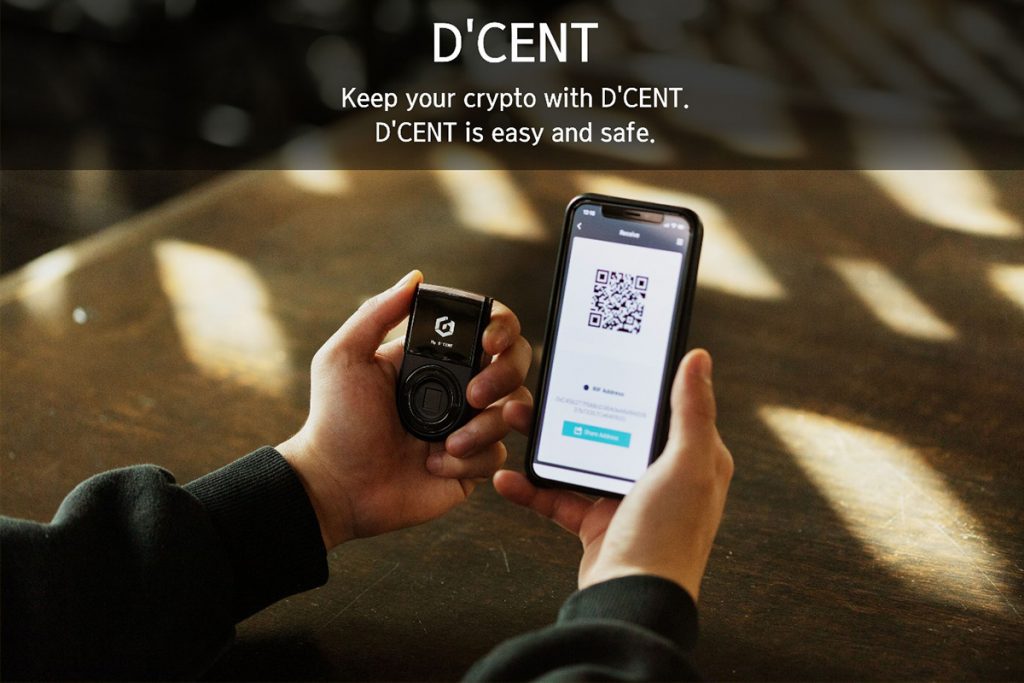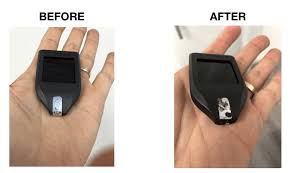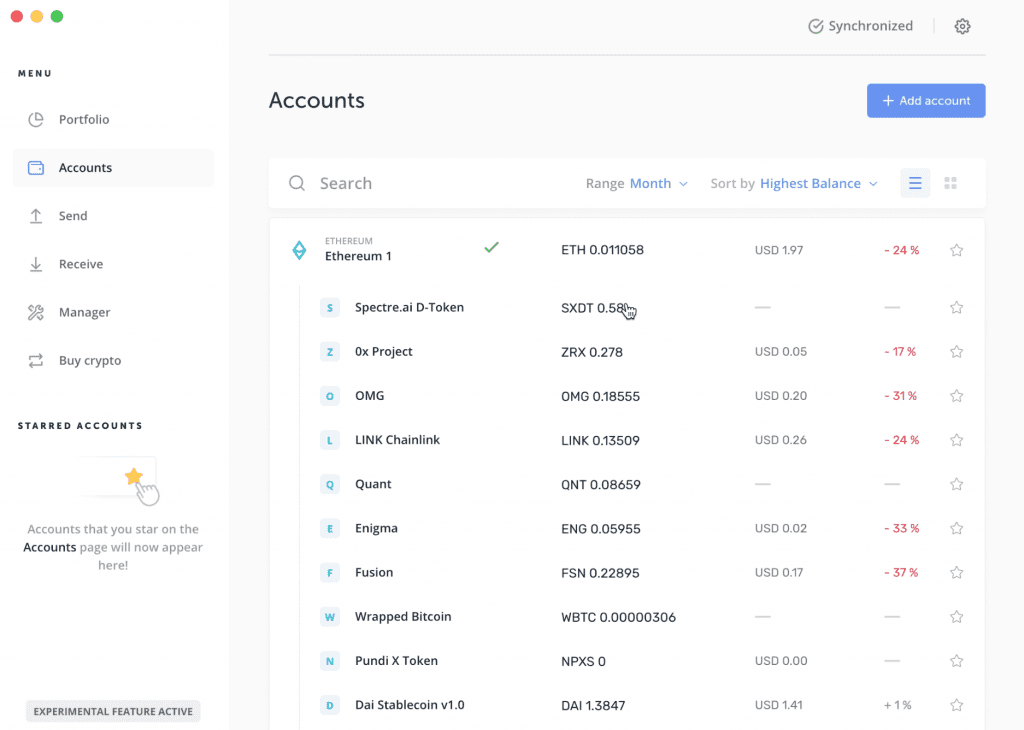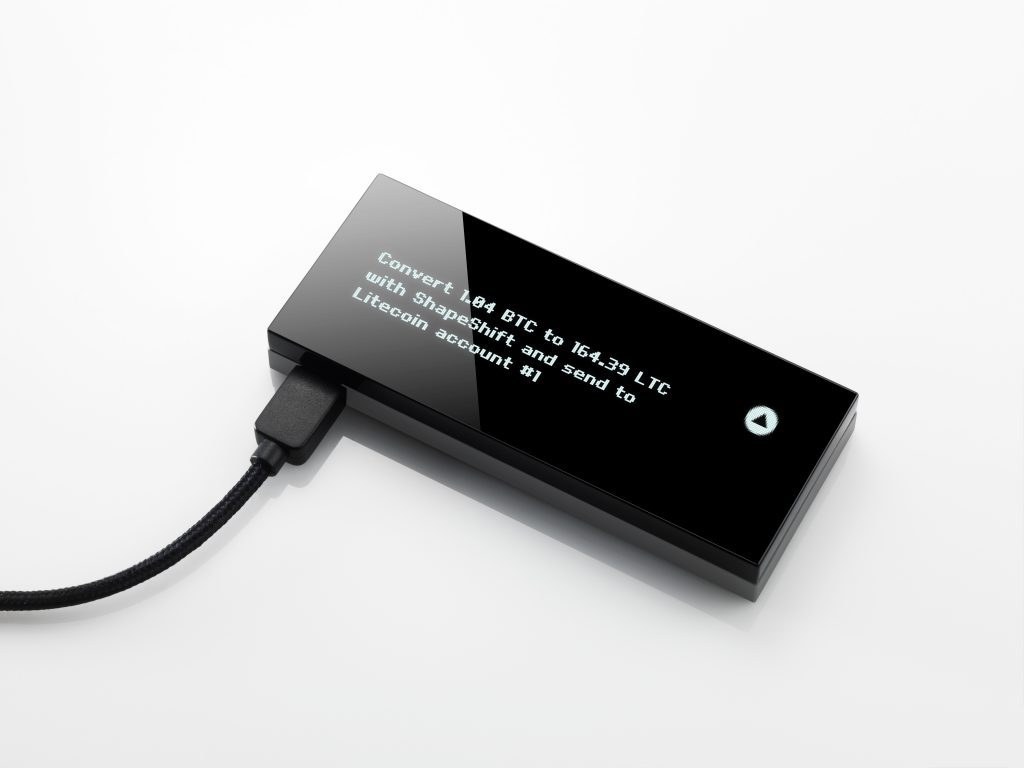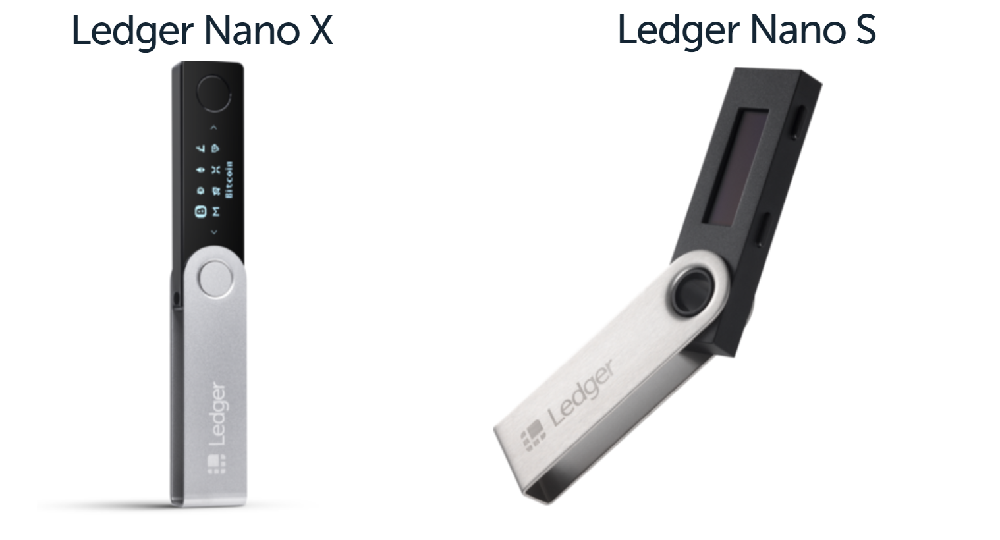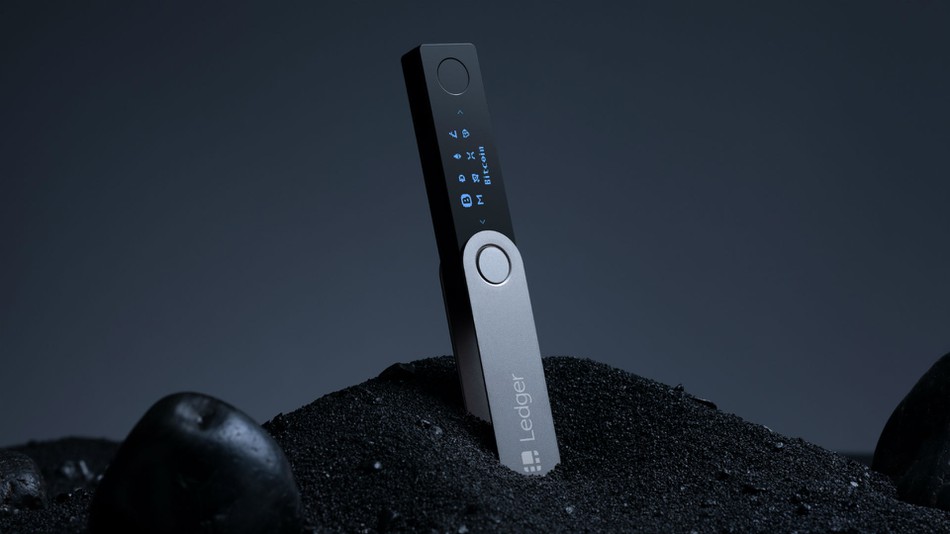- CRYPTO HARDWARE WALLETS
- NGRAVE ZERO
- COMPARE HARDWARE WALLETS
- KEEPKEY VS TREZOR VS LEDGER
- TREZOR VS TREZOR REVIEW
- KEEPKEY VS LEDGER NANO X
- LEDGER NANO X VS ELLIPAL TITAN
- LEDGER NANO X VS TREZOR MODEL T
- D’CENT VS LEDGER NANO X
- SAFEPAL VS LEDGER NANO S
- BC VAULT VS LEDGER NANO X
- BC VAULT VS D’CENT
- BC VAULT VS KEEPKEY
- SECUX V20 VS LEDGER NANO X
- D’CENT VS SAFEPAL
- SAFEPAL VS BC VAULT
- SAFEPAL VS KEEPKEY
- SAFEPAL VS ELLIPAL TITAN
- ELLIPAL TITAN VS KEEPKEY
- ELLIPAL TITAN VS BC VAULT
- ELLIPAL TITAN VS D’CENT
- KEEPKEY
- LEDGER NANO S
- LEDGER NANO X
- TREZOR ONE
- TREZOR MODEL T
- ELLIPAL TITAN
- ELLIPAL 2.0 (1st GEN)
- KEYSTONE PRO
- COOL WALLET S (WIRELESS)
- SAFEPAL S1
- D’CENT
- BC VAULT
- SECUX W10
- SECUX W20
- SECUX V20
- SECUX NIFTY
- KEEVO WALLET
- CYPHEROCK X1
- RECOVERY SEED BACKUPS
- PRODUCT REVIEWS
- VIDEOS
- RESOURCES
- CONTACT US
- Logo
- Facebook




- Instagram






- Twitter






- Youtube






- FREE E-BOOK






Ledger
Tezos Ledger Nano X: Why I Stake My Tezos On My Ledger Nano X (2020)
In this review, we are going to see the SAFEST way to store your tezos ledger nano x, simulatenously! Tezos is self-amending, meaning that it does not need to go through regular hard forks in order to be upgraded. Even when hard forks are agreed upon by an entire network, they can create a lot of work for developers and node operators. Tezos has a more seamless upgrade process that does not involve regularly forking the blockchain. That said, it is possible for part of the network to decide to fork Tezos indeed, this has already happened during the initial KYC controversy.
The Tezos coin (XTZ) can be obtained through a number of prominent exchanges, including Kraken and Binance. Each exchange has different trading pairs, meaning that you can purchase XTZ by spending ETH, BTC, Tether, or fiat currency.
Traditional proof-of-stake, which is used in Ethereum’s upcoming Casper protocol, allows node operators to lock up their own tokens for a chance to validate blocks and earn token rewards. This system allows an unlimited number of nodes to vie for control over block validation, and the fact that countless stakers can exist makes the model highly decentralized. Unfortunately, staking is too expensive for many basic users: even if Ethereum lowers the minimum staking amount to 32 ETH, staking will still require thousands of dollars.
Meanwhile, delegated proof-of-stake (DPoS) allows users to stake their tokens in order to vote for a limited number of block producers. EOS, for example, elects only 21 block producers, all of whom are large organizations that must dedicate massive amounts of computing power. This model has come under fire for centralizing power in the hands of a few block producers.
However, delegation and voting make it possible for less wealthy users to have an indirect say over the course of the blockchain. Tezos combines these two models with its unique liquid proof-of-stake mechanism. This model allows up to 80,000 block validators or bakers to accept delegated tokens. Bakers must hold 10,000 XTZ, which is, again, thousands of dollars.
However, Tezos also allows users with smaller holdings to delegate their tokens to bakers and receive rewards in return. In other words, liquid proof-of-stake permits users to either become a full-fledged block validator or merely delegate tokens to validators. The following infographic gets into some of the specifics of the baking process, which involves unique features like a “quality assurance team” and a “bonding” or “cooldown” phase: Just like Ethereum and EOS, Tezos supports smart contracts, which are blockchain programs that can execute automatic transactions.
Tezos Ledger Nano X: How Do I Stake My Tezos On My Ledger Nano X?
Staking with Tezos (XTZ) – Earn money while holding crypto assets | Ledger Staking is the process of holding funds in a cryptocurrency wallet to support the operations of a blockchain network and, in return, holders are rewarded for their contribution. This can be compared to earning interest in a traditional bank. Tezos is a multi-purpose blockchain which uses a Proof-of-Stake protocol to secure its network. Token holders can delegate their accounts to a validator, who will be in charge of securing the network on their behalf.
Tezos Ledger Nano X: How Do I Set Up Baking Tezos On My Ledger Nano X?
The user may then earn the rewards generated minus validator’s fees. Discover Ledger Live When staking, you can earn a passive income by participating in the Tezos network via delegation. The current annual yield on Tezos is around 6%, minus a validator’s fees. You can use Staking Reward’s calculator to estimate your monthly earnings.
When you first start delegating, it will take roughly five weeks for you to receive your first rewards from your validator. After this, you can expect rewards about every 3 days. In Tezos, the current consensus mechanism is known as Liquid Proof-of-Stake (LPoS).
Token holders can delegate their validation rights to other token holders (called validators) without transferring ownership of their tokens. Contrary to other DPoS protocol, in Tezos you delegate your whole account. When delegating, your XTZ are completely liquid. You are free to move your tokens anytime as there are no freezing periods when delegating to a validator. There are no direct risks of delegating XTZ. The only risk you take is not earning the potential rewards.
How Can I Earn Passive Income With Tezos?
Carefully choose your validator to ensure quality of service and rewards. Select the Tezos account you want to delegate in Ledger Live Choose your validator (baker) by comparing estimated reward rate Verify and confirm delegation information on your Ledger hardware wallet Tezos token holders who are not interested in being a baker themselves can delegate their tokens to a validator to bake on their behalf.
When performing a delegation operation, you only send your baking rights to a validator: your XTZ stay on your wallet and remain yours. As you retain ownership of your assets, you can keep your XTZ on your hardware wallet while staking via delegation. This is the best way to keep your assets safe.
You can bake on your own by setting up a node and having at least 8.000 XTZ (8.000 XTZ is called a “roll”). Baking yourself requires you to run a Tezos node, a baker & endorser client. You should have a reliable Internet connection and high-availability servers. The more delegated funds a baker receives, the greater the chance it has to produce blocks and earn rewards.
Tezos Ledger Nano X: Final Verdict
Overall, this article gives you a high level view of how Tezos works and how you can make money by “baking” your coins to help validate transactions on the network. You can spend a lot more money and become a “baker”, however that is out of reach for most people. This is why I use my Ledger Nano X to earn passive income, WHILE keeping my private keys safe and in my possession.
Don’t be fooled and believe that you can only do this on an exchange. That is the WORST way to do this, as you are making the money, and letting them keep possession of your keys. It’s easy to setup and you don’t need ANY technical knowledge to do this. In the video above, it explains how I easily did this and how you can too.
If you own and believe in the Tezos Project, there is no reason why you should not be earning passive income while doing so, in the safest way possible. What are you waiting for? Get a Ledger Nano X now so you can safely stake your rewards and not risk leaving your private keys on on an exchange or hot wallet, where you are at risk!
Secux V20 vs Ledger Nano X (2020) | Does Ledger Have Some Bluetooth Competition?
Secux V20 vs Ledger Nano X! In this comparison, we are going to do a head-to-head of two of the most competitive and popular new cryptocurrency hardware wallets in this edition of the hardware wallet roundups.
I am going to dive into which of these bluetooth hardware wallets is better and more secure. How big is your portfolio? Do you need mobile AND desktop support? Do you use any 3rd party wallets for integration? Do you need web-based access instead of a required download?
These are all questions you will need to consider when deciding which of these wallets will be best for you. At the end of the day, the coin support is one of the most important factors (besides security) when deciding which hardware wallet is best for you.
Ultimately, if it doesn’t support the coins you want to store offline, it won’t work for your particular situation. So keep that in mind as we dive into what I consider to be the most important factors when making such an important decision, such as choosing a cryptocurrency hardware wallet.
Ledger Nano X: Overview
The Nano X comes beautifully packaged with the device itself, a USB-C cable, a set of instructions and recovery seed cards. The previous bulky buttons that were on top of the device are now seamlessly integrated on it in a way that’s even a bit hard to notice. All in all a beautiful design. The primary features of this device are the bluetooth connection which allows you to manage this device using your smartphone via the iOS and Android app.
Additionally, you can now hodl, store, or manage up to 100 cryptos simultaneously, all without access to your desktop or laptop computer. This is easily it’s best new features, but aside from the upgraded storage capacity and the wireless connectivity, the device itself is now larger, has an integrated 2-function button, and an overall larger screen for verifying transactions. With a trusted device and a more universal charging cable, this makes it much more compelling to spend the extra money to store more coins and one that you can easily take with you as you travel.
Ledger Nano X: Security


Ledger is at the forefront of developing the industry’s device security. How? And in what ways?
CC EAL5+ SECURE ELEMENT
Only Ledger’s devices can claim the French cybersecurity agency ANSSI’s full certification.
The Nano X and Nano S both feature what is called a ‘secure element’. The chip seen below is the next generation chip that comes in the Nano X:
The secure chip meets the CC EAL5+ certification and run’s Ledger’s proprietary BOLOS operating system.
A Secure Element is a secure chip that…embeds intrinsic countermeasures against many known attacks. This kind of chip is tamper-resistant and protects your device to a range of different attacks.”
Ledger Nano X: User Experience (UX)
Honestly, the user experience is a massive upgrade from the Ledger Nano S. With that said, It has a few usability issues that I find to be quite difficult to overcome. Although this device is physically larger than it’s predecessor, it still has a fairly difficult to use early experience.
For example, the screen is still fairly small and still cannot accommodate a QR code for scanning. This may not seem like a big deal, but after using several hardware wallets, it really does make a big difference. Using a QR code is not only safer (because it removes the chance of error from manually typing in a wallet address), but it is incredibly faster and makes the entire of transacting offline, a much easier experience.
Although this device has stepped up the quality considerably from it’s latest iteration, I still feel that utilizing an all new form factor could have been beneficial and a little more innovative than replicating their 1st generation device with a few small tweaks.
Ledger Nano X: Coin Support


The Ledger Nano X utilizes the “Ledger Live” dashboard which is a desktop application that allows you to manage all of your coins, portfolio, and potential trades in an easy to use application. You can use this on both an iOS or Android app as well as a desktop.
This app allows you to manage up to 1,100 coins that are supported by the device. However, only about 200 of them are “native” apps. This means that you can manage them directly within the Ledger Live app, without having to connect to a 3rd party wallet, such as MyEtherWallet or MyCrypto. I will leave a link HERE with a list of fully supported coins.
Secux V20: Overview
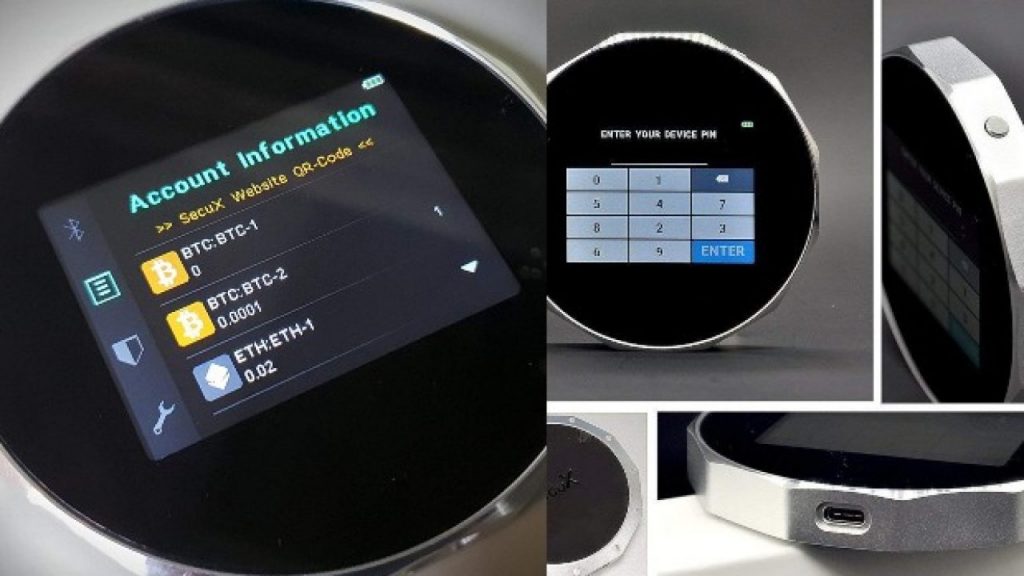

After unboxing and looking at the SecuX V20 device, I was pleasantly surprised that the overall quality and screen size was much larger than other mid-tier devices in this price range, such as the Ledger Nano X and the Trezor Model T. Now, those devices are classic and original devices, but they are tiny and made of a somewhat flimsy, plastic form-factor.
This device has a beautiful brushed aluminum reinforced hardware wallet. It has a clean flat display and the back has a durable padding rubber-like backing that is built for abuse and stability. I would have no qualms with dropping this device as it’s built very solidly and feels heavy in your hand, unlike their entry-level devices. The SecuX V20 has only one MicroUSB port and one button for activating the device and for 2FA.
The SecuX V20 device is the only one with a unique form factor and octagon design that is very sleek and very durable. This device is connected by bluetooth! That means it has wireless support and can be managed with full functionality by the SecuX app for iOS and Android. It also has a USB cable, so it can be managed online with a web wallet as well, hence, why it’s considered a “Cross-Platform” device.
The unique and notable coins that are natively supported on these devices is Groestlcoin (GRS) and Ripple (XRP). Not many hardware wallets support these coins natively, however, almost all hardware wallets support an array of ERC-20 tokens and your main-stream coins, like BTC and ETH.
Secux V20: Security


The SecuX V20 is placed with a CC EAL 5+ Certified Security Element (SE) which always ensures that stored private keys, as well as the device PIN code, are perfectly protected against any form of attack. Other significant security features include:
- Pre-installed tamper-resistant firmware as well as an upgrade system
- Physical confirmation for every transaction
- A one-time password or custom PIN code for controlling device access or the wallet apps
- Anti-tamper packaging
- Randomized digital keyboard for preventing consequences of keystrokes
Also, the wallet complies with the BIP32, BIP39 and BIP44 standards which allow the user to generate passwords of 12, 18 and 24 words for funds recovery.
Secux V20: User Experience (UX)
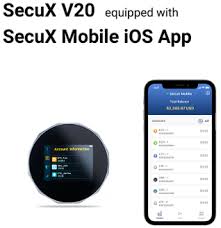

The picture below showcases the key features of this device, is the “Cross-Platform Support”, which means it can be managed via desktop, laptop, and mobile. Now, as I mentioned this device CAN conduct transactions via the mobile app, but also the Secux W20 can too, as they are bluetooth enabled.
This truly is one of the first multiple platform devices that you can manage on the big desktop screen, as well as wirelessly on the go. It has a 600mAH battery which can be charged from an empty battery within 30 minutes on the second charge
Secux V20: Coin Support
This is usually the most important factor when considering the hardware that you choose. This top-tier wallet from SecuX has support for the following coins as of this writing: BTC, ETH, XRP, BCH, GRS and LTC. It also supports all ERC-20 tokens as well.
Luckily, they update the firmware frequently and they plan on adding more coins as well in the near future. If you are new to “HODLing” and you do not need any specific coins outside of these top market cap coins and ERC-20 Ethereum-based tokens to start, then this is a good option.
Secux V20 vs Ledger Nano X: Conclusion
Overall, the SecuX V20 is a robust, and very secure wallet. For the price point, features and capabilities, the only thing that is comparable is the Ledger Nano X, which is also a bluetooth and wireless crypto wallet using the same security chip.
With the Ledger Nano X, it comes in a little cheaper at $119, and it also allows you to hold 100 apps (or different cryptocurrencies simultaneously), but it comes in a cheap and somewhat flimsy plastic enclosure that has a very tiny screen. Personally, I prefer a larger display and I’ve used almost all (if not all) hardware wallets out there, and confirming the address you’re sending to is MUCH easier to do on a large, bright, full color display. Additionally, this device has QR code support, which makes it easier when sending funds from a mobile wallet directly to your hardware wallet.
The one thing I did NOT like about the SecuX V20 is the lack of coin support with only 6 coins supported natively, and a handful of more coins to be supported in the future. If you plan on only “HODLing” the top 5 market-cap coins and perhaps a few ERC-20 tokens, I would probably say this is a better option and has a much cleaner and larger display for managing and verifying transactions.
With my discount, (Code: BITCOINLOCKUP), it will take the price to around $134 and free shipping. When compared to other entry level wallets, you can’t beat the sturdiness and large screen (which is more important than you think), when managing your assets offline.
What do you think? Would you choose the Secux V20 over the Ledger Nano X? Let us know down below in the comments!
Cheers,
The Crypto Renegade
NOTE: This post may contain affiliate links. This adds no cost to you but it helps me focus on giving as much value as possible in every single post by being compensated for recommending products that help people succeed.
BC VAULT vs Ledger Nano X (2020) | Are These Hardware Wallets Worth It?
BC VAULT vs Ledger Nano X! In this comparison, we are going to do a head-to-head of two of the most competitive and popular new cryptocurrency hardware wallets in this edition of the hardware wallet roundups.
I am going to dive into which of these hardware wallets is better and more secure. How big is your portfolio? Do you need mobile AND desktop support? Do you use any 3rd party wallets for integration? Do you need web-based access instead of a required download?
These are all questions you will need to consider when deciding which of these wallets will be best for you. At the end of the day, the coin support is one of the most important factors (besides security) when deciding which hardware wallet is best for you.
Ultimately, if it doesn’t support the coins you want to store offline, it won’t work for your particular situation. So keep that in mind as we dive into what I consider to be the most important factors when making such an important decision, such as choosing a cryptocurrency hardware wallet.
Ledger Nano X: Overview
The Nano X comes beautifully packaged with the device itself, a USB-C cable, a set of instructions and recovery seed cards. The previous bulky buttons that were on top of the device are now seamlessly integrated on it in a way that’s even a bit hard to notice. All in all a beautiful design. The primary features of this device are the bluetooth connection which allows you to manage this device using your smartphone via the iOS and Android app.
Additionally, you can now hodl, store, or manage up to 100 cryptos simultaneously, all without access to your desktop or laptop computer. This is easily it’s best new features, but aside from the upgraded storage capacity and the wireless connectivity, the device itself is now larger, has an integrated 2-function button, and an overall larger screen for verifying transactions. With a trusted device and a more universal charging cable, this makes it much more compelling to spend the extra money to store more coins and one that you can easily take with you as you travel.
Ledger Nano X: Security
Ledger is at the forefront of developing the industry’s device security. How? And in what ways?
CC EAL5+ SECURE ELEMENT
Only Ledger’s devices can claim the French cybersecurity agency ANSSI’s full certification.
The Nano X and Nano S both feature what is called a ‘secure element’. The chip seen below is the next generation chip that comes in the Nano X:
The secure chip meets the CC EAL5+ certification and run’s Ledger’s proprietary BOLOS operating system.
A Secure Element is a secure chip that…embeds intrinsic countermeasures against many known attacks. This kind of chip is tamper-resistant and protects your device to a range of different attacks.”
Ledger Nano X: User Experience (UX)
Honestly, the user experience is a massive upgrade from the Ledger Nano S. With that said, It has a few usability issues that I find to be quite difficult to overcome. Although this device is physically larger than it’s predecessor, it still has a fairly difficult to use early experience.
For example, the screen is still fairly small and still cannot accommodate a QR code for scanning. This may not seem like a big deal, but after using several hardware wallets, it really does make a big difference. Using a QR code is not only safer (because it removes the chance of error from manually typing in a wallet address), but it is incredibly faster and makes the entire of transacting offline, a much easier experience.
Although this device has stepped up the quality considerably from it’s latest iteration, I still feel that utilizing an all new form factor could have been beneficial and a little more innovative than replicating their 1st generation device with a few small tweaks.
Ledger Nano X Coin Support
The Ledger Nano X utilizes the “Ledger Live” dashboard which is a desktop application that allows you to manage all of your coins, portfolio, and potential trades in an easy to use application. You can use this on both an iOS or Android app as well as a desktop.
This app allows you to manage up to 1,100 coins that are supported by the device. However, only about 200 of them are “native” apps. This means that you can manage them directly within the Ledger Live app, without having to connect to a 3rd party wallet, such as MyEtherWallet or MyCrypto. I will leave a link HERE with a list of fully supported coins.
BC VAULT: Overview
Unlike most other popular cryptocurrency hardware wallets, like Ledger Nano X and Trezor Model T, you do not set up a recovery seed card before you initialize the device. In fact, there is a gyro sensor for you to randomly generate private keys by physically shaking the device (seriously).
You can also hold more than 2000 unique wallets within the web app, and can granularly set specific passwords for each one and setup multiple PIN’s to not only make it more secure, but also allows for an easy way to share the device and use Multi-Sig. In fact, this is the first device that natively allows you to use Multi-Sig on a per wallet basis and set multiple PIN’s.
This wallet does not use HD wallets, so each wallet has its own unique backup. This does make it more secure, however, if you lose or forget the global PIN and global password for the device, your funds are locked inside forever. They do have an encrypted QR code backup for each individual wallet, or you can create a backup on the included micro SD card that comes in the box.
BC VAULT: Security
The storage is reliable. The BC Vault’s private keys have complete encryption and they are stored in the FRAM device. The FRAM is fully tamper-resistant and thanks to the reversible USB 3.0 Type-C connector any damage occurring from mechanical error is fully prevented.
In addition to the secure FeRAM that is securely encrypted, and the large display which is useful when confirming transactions, you have peace of mind not having to worry about anyone locating or using a recovery seed phrase to render your funds useless.
You can also import any private keys you have elsewhere via the SD card as well, so you can easily interchange private keys from other wallets if you have them in the correct format.
BC VAULT: User Experience (UX)
This wallet has some pretty unique features I will admit, and it’s pretty refreshing. For example, you can use multiple cryptocurrencies at once. There are no “apps” you need to install or fear or worry of running out of space that most wallets have when upgrading the firmware.
Additionally, the amount of coins and wallets that can be used/stored simultaneously is astounding. As mentioned above, you can have up to 2000 unique wallets and can interchange multiple cryptos in multiple wallets.
BC VAULT: Coin Support
This is usually one of the most important factors when deciding on a hardware wallet (with the exception of security). If the wallet doesn’t currently support the coins you need to store offline, you can’t really take it too seriously as a deciding factor for purchase. Regardless of whether or not they claim to add more coins in the future.
Needless to say, they have some unique choices for coin support HERE.
BC VAULT vs Ledger Nano X: Conclusion
Overall, these are two highly regarded hardware wallets with unique properties in its own right. If you want to have the flexibility of being able to use this device on the go and utilize it via a smartphone app, then you should go with the Ledger Nano X. If you want something that has a MASSIVE portfolio support and lots of customizable security, you should go with the BC VAULT.
At the end of the day, it really depends on your personal preference and what your immediate needs are. Now, I have used both of these devices extensively and I have a clear favorite (check out the details in the above video). If I only had to choose one of these devices, I would choose the BC VAULT, it has a very unique and strong security model, it can hold up to 2000 wallets simultaneously, and can support multi-sig, which allows for mutliple users to securely use the same wallet and requires a set number of users in order to send money.
Not only that, you can SECURELY share this device with multiple people as all of these wallets are encrypted and can have multiple custom passwords. I would truly feel confident handing this hardware wallet to my friend with over 10 BTC on it, because I know he will have no way to access the funds within my wallet. I can’t say that about the Ledger Nano X.
All in all, these both are great wallets and you ultimately need to decide what coins you need to store offline, how many coins you need to store at once, and if you need mobile support. These are all very personal, and in my case, I would rather sacrifice the mobile support to have a very easy to use multi-sig hardware wallet with the ability to share it with family, friends, or even a new business.
What do you think? Would you choose the BC Vault over the Ledger Nano X? BC VAULT vs Ledger Nano X! Let us know down below in the comments!
Cheers,
The Crypto Renegade
NOTE: This post may contain affiliate links. This adds no cost to you but it helps me focus on giving as much value as possible in every single post by being compensated for recommending products that help people succeed.
SafePal vs Ledger Nano S (2020) | Which Entry Level Hardware Wallet Is Better?
SafePal vs Ledger Nano S! In this comparison, we are going to do a head-to-head of two of the most competitive and popular new cryptocurrency hardware wallets in this edition of the hardware wallet roundups.
I am going to dive into which of these entry-level hardware wallets is better and more secure. How big is your portfolio? Do you need mobile OR desktop support? Do you use any 3rd party wallets for integration? Do you need web-based access instead of a required download?
These are all questions you will need to consider when deciding which of these wallets will be best for you. At the end of the day, the coin support is one of the most important factors (besides security) when deciding which hardware wallet is best for you.
Ultimately, if it doesn’t support the coins you want to store offline, it won’t work for your particular situation. So keep that in mind as we dive into what I consider to be the most important factors when making such an important decision, such as choosing a cryptocurrency hardware wallet.
Ledger Nano S: Overview
The Ledger Nano S is a very compact, sleek, and secure device that allows you to store over 1,100 cryptocurrencies at the time of this writing. This is crucial as more altcoins gain acceptance and you need a wide portfolio to protect longer term. Ledger takes their security very seriously and for good reason. There have been a number of exchange hacks and reports of people losing or having their wallets hacked by nefarious individuals throughout history. This is why having this device is so crucial.
Ledger Nano S is a device that is upgraded frequently with new features and firmware upgrades to ensure that it has the latest security protections and new assets being added every single month. Not to mention, it is currently the cheapest among the 3 best-known hardware wallet companies, starting at only $59 USD!
Ledger Nano S: Security
The Ledger Nano S has an A-grade security setup which sets it apart from the competition. It uses a secure element which holds and stores the private keys in a separate and secure environment from the rest of the operating system. This ensures that if for any reason the rest of the device is somehow compromised, you precious private keys are safe.
It also supports the standards BIP-39 protocol that requires you to setup a recovery seed phrase of 24 words during the initial setup, that allows you to restore your coins to any other wallet in the event you have broken, lost, or somehow cannot gain access to the device itself, so you have a fail safe.
Ledger Nano S: User Experience (UX)
I will keep this section short and sweet, as I addressed above, this is a sleek and compact device, which makes it very stable and durable. It has a small OLED screen and 2 physical buttons. This is used for navigating apps, verifying your pin to access to the device, confirming a transaction, and generating the recovery seed words upon first time setup.
When entering in your PIN on the device, the right button will function as the “Up” arrow, and the left button the “Down” arrow for scrolling through your selections, then pressing both at the same time will confirm your selection, so it’s pretty intuitive. It has a one port which is micro USB that connects to a cable to a standard USB port that can be used on a MAC or PC.
Ledger Nano S: Coin Support
Technically, this device supports over 1,000 different coins, with a few caveats below. I will also leave a link for the full list of supported coins HERE.
– You can really only hold 3 or 4 apps on the device at once. I originally only kept 3 apps on the device, as those were the only coins I needed to add at the time. However, when I went to add a 4th, it told me I needed to remove an existing app to make room. The RAM or space is on the device is very limited, so it’s good if you have only 2-3 coins you want to manage at once.
-They require you go through the process of removing and uninstalling all apps and then going in and reinstalling them for EVERY firmware update. This is tedious and really obnoxious for the serious hardware wallet user. I understand you need to have backups and be careful with every upgrade but c’mon, this is the only device I have this issue with.
SafePal: Overview
This device was originally created by Binance Labs division and wanted to have a unique approach to a hardware wallet that was cheap enough for the average user, but also supported the Binance chain and added support for their internal projects. This really is a unique entry level hardware wallet, that greatly differs in terms of design, functionality, and overall user experience.
SafePal: Security
This can be considered one of the most attractive features of the device as it’s only $39.99 for this hardware wallet. Yes, you read that right. But why is it so cheap? Well, even though it looks like a very sleek and expensive device, its is made of plastic coating and a very small camera module that is used to transact at a very low resolution.l It’s obvious that they built this as cheaply as they could, while still remaining secure.
This is not necessarily a bad thing, but you also get what you pay for. One of the key features that sets this device apart from most other competing hardware wallets is the fact that there is NO:
- NFC
- BLUETOOTH
- USB
- CELLULAR
- EXTERNAL DEVICE CONNECTIONS
This gives it extra security, but it also makes it easier to use, as there are no extra devices necessary for this to operate, other than your smartphone. All you need right out of the box is a charger that supports USB-A to charge the device and a smartphone to download the SafePal App to setup and initialize the device.
SafePal: User Experience (UX)
This is the cheapest completely wireless hardware wallet on the market. It interacts only with your smartphone and the camera embedded into the device that allows you to transmit encrypted data via the QR code. This is truly a unique device.
This is a pretty solid introductory hardware wallet. It’s unique from its direct competitors and its simple and easy to use. As mentioned above, it has no connection weaknesses and cannot be hacked by any radio frequency or directly connected internet device. It’s truly a unique wireless hardware wallet that can be used on the go and is one of only a few hardware wallets that are “truly wireless” with no dependence on other devices. Oh, and did I mentioned it’s under $50?
SafePal: Coin Support
This is the one weal point of this product is the lack of coin support, as it only supports: Bitcoin, Ether (and ERC-20 Tokens), BNB, Litecoin, Dash, and Bitcoin Cash. However, they have mentioned that there is Ripple (XRP) and Tron (TRX) coming very shortly. They truly are attempting to add more coins, and over time, if they don’t raise their price, this option will be a slam dunk for most users.
Additionally, I will add that the Binance Chain Coins (BEP2) tokens are also supported as this is a Binance hardware wallet after all. Below Is a full list of coins currently supported.
SafePal vs Ledger Nano S: Conclusion
At the end of the day, these are the two most trusted entry level hardware wallets on the market today. They both have an entry point under $60 (which is very cheap considering the competition), and the SafePal is currently on sale for under $40.
On the one hand, the Ledger Nano S has a massive development team and “technically” supports over 1,000 coins, however, as I mentioned above, it really only allows you to hold 3-4 coins on the device at once. The coin selection is a very nice feature, especially if you want to expand and swap out your portfolio. However, even though the SafePal does not hold nearly as many coins (currently), it is VASTLY more secure.
Having no connection to USB, Bluetooth, or any other transmission method other than an encrypted QR code via a camera, is a very attractive selling point. Not to mention the fact that you don’t need a computer and a USB connection to use it, makes it more accessible for a much larger market.
Personally, it really just depends on your current situation. You need to ask yourself: “What coins do I need to store offline?” “Am I ok with having to use a computer to use this device?” “Do I want to hold more than 3 different coins at once on the device?”. If it were me, I would choose the SafePal. This by NO means the Ledger Nano S is a bad device, I just believe the fact that I can use the SafePal with a smartphone and also having no insecurities makes it a very compelling choice. The fact that it’s currently cheaper is just a bonus.
What do you think? Would you choose the SafePal over the Ledger Nano S? SafePal vs Ledger Nano S! Let us know down below in the comments!
Cheers,
The Crypto Renegade
NOTE: This post may contain affiliate links. This adds no cost to you but it helps me focus on giving as much value as possible in every single post by being compensated for recommending products that help people succeed.
D’CENT vs Ledger Nano X (2020) | Which Bluetooth Hardware Wallet Is Safer?
D’CENT vs Ledger Nano X! In this comparison, we are going to do a head-to-head of two of the most competitive and popular new cryptocurrency hardware wallets in this edition of the hardware wallet roundups.
I am going to dive into which of these bluetooth hardware wallets is better and more secure. How big is your portfolio? Do you need mobile AND desktop support? Do you use any 3rd party wallets for integration? Do you need web-based access instead of a required download?
These are all questions you will need to consider when deciding which of these wallets will be best for you. At the end of the day, the coin support is one of the most important factors (besides security) when deciding which hardware wallet is best for you.
Ultimately, if it doesn’t support the coins you want to store offline, it won’t work for your particular situation. So keep that in mind as we dive into what I consider to be the most important factors when making such an important decision, such as choosing a cryptocurrency hardware wallet.
Ledger Nano X: Overview
The Nano X comes beautifully packaged with the device itself, a USB-C cable, a set of instructions and recovery seed cards. The previous bulky buttons that were on top of the device are now seamlessly integrated on it in a way that’s even a bit hard to notice. All in all a beautiful design. The primary features of this device are the bluetooth connection which allows you to manage this device using your smartphone via the iOS and Android app.
Additionally, you can now hodl, store, or manage up to 100 cryptos simultaneously, all without access to your desktop or laptop computer. This is easily it’s best new features, but aside from the upgraded storage capacity and the wireless connectivity, the device itself is now larger, has an integrated 2-function button, and an overall larger screen for verifying transactions. With a trusted device and a more universal charging cable, this makes it much more compelling to spend the extra money to store more coins and one that you can easily take with you as you travel.
Ledger Nano X: Security
Ledger is at the forefront of developing the industry’s device security. How? And in what ways?
CC EAL5+ SECURE ELEMENT
Only Ledger’s devices can claim the French cybersecurity agency ANSSI’s full certification.
The Nano X and Nano S both feature what is called a ‘secure element’. The chip seen below is the next generation chip that comes in the Nano X:
The secure chip meets the CC EAL5+ certification and run’s Ledger’s proprietary BOLOS operating system.
A Secure Element is a secure chip that…embeds intrinsic countermeasures against many known attacks. This kind of chip is tamper-resistant and protects your device to a range of different attacks.”
Ledger Nano X: Coin Support
The Ledger Nano X utilizes the “Ledger Live” dashboard which is a desktop application that allows you to manage all of your coins, portfolio, and potential trades in an easy to use application. You can use this on both an iOS or Android app as well as a desktop.
This app allows you to manage up to 1,100 coins that are supported by the device. However, only about 200 of them are “native” apps. This means that you can manage them directly within the Ledger Live app, without having to connect to a 3rd party wallet, such as MyEtherWallet or MyCrypto. I will leave a link HERE with a list of fully supported coins.
Ledger Nano X: User Experience
Honestly, the user experience is a massive upgrade from the Ledger Nano S. With that said, It has a few usability issues that I find to be quite difficult to overcome. Although this device is physically larger than its predecessor, it still has a fairly difficult to use early experience.
For example, the screen is still fairly small and still cannot accommodate a QR code for scanning. This may not seem like a big deal, but after using several hardware wallets, it really does make a big difference. Using a QR code is not only safer (because it removes the chance of error from manually typing in a wallet address), but it is incredibly faster and makes the entire of transacting offline, a much easier experience.
Although this device has stepped up the quality considerably from it’s latest iteration, I still feel that utilizing an all new form factor could have been beneficial and a little more innovative than replicating their 1st generation device with a few small tweaks.
D’CENT Wallet: Overview
The D’CENT is a mobile and bluetooth connected wireless hardware wallet device. With additional biometric security and the ease of use, this is a contender for the easiest to use mobile and wireless wallet. So how is it different than Ledger Nano X or other bluetooth devices? The Biometric security is a large differentiator here. It’s super convenient and makes it easy to sign and authenticate transactions on the go.
This means if you want to move your crypto from cold storage to a hot wallet, it can be done quickly and easily. A common scenario here would be if you are trying to pay a friend or you’re shopping and want to pay for a product in store very seamlessly. Let’s take a look at the security, features, and price below to go into a little more detail.
D’CENT: Security
The flagship feature of D’CENT is hands down the biometric security feature of the fingerprint sensor. There are some other hardware wallets that communicate with mobile, and can utilize Face ID or Touch ID for extra authentication with their mobile app, but this gives your authentication on the physical device as well. This is a unique and very secure feature that is not used by any other hardware wallet currently on the market.
The hardware wallet features a built-in fingerprint scanner that manages access to the hardware wallet. This security process improves the convenience for the users and enhances the security during access control. It also provides the wallet with fast transaction signing.
- Multi-IC architecture design
- Bank grade EAL 5+ Secure Element (This is the same security chip used in the Ledger Nano X)
- Secure OS embedded on microprocessor
D’CENT: Coin Support
The coin support is varied. The D’CENT can store and support Bitcoin, Ethereum, ERC20 tokens, RSK, RRC20 (RSK tokens), Ripple (XRP), and MONACOIN. To many, this may not seem like it is very much, however, a majority of the major tokens are ERC-20 tokens and all can be supported natively on this device, which is good. I have not come across a hardware wallet yet that supports RSK and RRC20 tokens yet natively, so that definitely makes this an exclusive hardware wallet first for the D’CENT wallet!
D’CENT: User Experience
One of the main features I like here is the option to generate a valid QR code on the large OLED screen of this device as a way to send funds directly from your smartphone to your D’CENT wallet. This is super convenient and truly makes this a wireless and independent device that can be used on the go via the D’CENT app, which also includes a market price section and of course all of your wallets and current fiat amount stored within each one.
What’s also nice is you no longer need to backup and restore this device for firmware upgrades like you do with other devices (although you can, since this device can also support bluetooth and USB connectivity if you choose). This makes this a very convenient choice when considering the ease of use and security when choosing how to secure your private keys.
D’CENT vs Ledger Nano X: Conclusion
Truth be told, these hardware wallets each have their own unique selling points (as you’ve seen above). It really depends on your situation. For example, if I only wanted to “HODL” the main market cap coins and wasn’t looking to build an expansive portfolio, I would choose the D’CENT wallet.
Why? Because the user experience in form factor is better (in my opinion) for ease of use, and overall security and the fingerprint authenticator gives me peace of mind. The Ledger Nano X is a solid device with a great track record and a trusted development team behind them. However, the screen size is not much bigger than their 1st generation device, and the form factor and user experience is much the same.
Overall, if I had to choose between these devices, it would really depend on which coins and the number of coins I needed to hold securely offline. They are both very high quality and fun devices in their own unique way. Having a bluetooth and wireless hardware wallet is really convenient and provides users a way to start using their hardware wallets in real-world scenarios. However, having that extra biometric security is really a game changer.
What do you think? Would you choose the KeepKey over the Ledger Nano X? Let us know down below in the comments!
Cheers,
The Crypto Renegade
NOTE: This post may contain affiliate links. This adds no cost to you but it helps me focus on giving as much value as possible in every single post by being compensated for recommending products that help people succeed.
Ledger Nano X vs Trezor Model T (2020) | Which 2nd-Generation Device Is Better?
Ledger Nano X vs Trezor Model T! In this comparison, we are going to do a head-to-head of two of the most competitive and popular new cryptocurrency hardware wallets in this edition of the hardware wallet roundups. In this comparison, I am going to dive into which of these 2nd-generation wallets is better. How big is your portfolio? Do you need mobile/wireless support? Do you use any 3rd party wallets for integration? Do you need web-based access instead of a required download?
These are all questions you will need to consider when deciding which of these wallets will be best for you. At the end of the day, the coin support is one of the most important factors (besides security) when deciding which hardware wallet is best for you. Ultimately, if if doesn’t support the coins you want to store offline, it won’t work for your particular situation, so keep that in mind as we dive into what I consider to be the most important factors when making a such an important decision, such as choosing a cryptocurrency hardware wallet.
So, let’s get right into the battle of Ledger Nano X vs Trezor Model T!
Ledger Nano X: Overview
The Nano X comes beautifully packaged with the device itself, a USB-C cable, a set of instructions and recovery seed cards. The previous bulky buttons that were on top of the device are now seamlessly integrated on it in a way that’s even a bit hard to notice. All in all a beautiful design. The primary features of this device are the bluetooth connection which allows you to manage this device using your smartphone via the iOS and Android app.
Additionally, you can now hodl, store, or manage up to 100 cryptos simultaneously, all without access to your desktop or laptop computer. This is easily it’s best new features, but aside from the upgraded storage capacity and the wireless connectivity, the device itself is now larger, has an integrated 2-function button, and an overall larger screen for verifying transactions. With a trusted device and a more universal charging cable, this makes it much more compelling to spend the extra money to store more coins and one that you can easily take with you as you travel.
Ledger Nano X: Security
Ledger is at the forefront of developing the industry’s device security. How? And in what ways?
CC EAL5+ SECURE ELEMENT
Only Ledger’s devices can claim the French cybersecurity agency ANSSI’s full certification.
The Nano X and Nano S both feature what is called a ‘secure element’. The chip seen below is the next generation chip that comes in the Nano X:
The secure chip meets the CC EAL5+ certification and run’s Ledger’s proprietary BOLOS operating system.
A Secure Element is a secure chip that…embeds intrinsic countermeasures against many known attacks. This kind of chip is tamper-resistant and protects your device to a range of different attacks.”
Ledger Nano X: User Experience
Honestly, the user experience is a massive upgrade from the Ledger Nano S. With that said, It has a few usability issues that I find to be quite difficult to overcome. Although this device is physically larger than its predecessor, it still has a fairly difficult to use early experience.
For example, the screen is still fairly small and still cannot accommodate a QR code for scanning. This may not seem like a big deal, but after using several hardware wallets, it really does make a big difference. Using a QR code is not only safer (because it removes the chance of error from manually typing in a wallet address), but it is incredibly faster and makes the entire of transacting offline, a much easier experience.
Although this device has stepped up the quality considerably from it’s latest iteration, I still feel that utilizing an all new form factor could have been beneficial and a little more innovative than replicating their 1st generation device with a few small tweaks.
Ledger Nano X: Coin Support
The Ledger Nano X utilizes the “Ledger Live” dashboard which is a desktop application that allows you to manage all of your coins, portfolio, and potential trades in an easy to use application. You can use this on both an iOS or Android app as well as a desktop.
This app allows you to manage up to 1,100 coins that are supported by the device. However, only about 200 of them are “native” apps. This means that you can manage them directly within the Ledger Live app, without having to connect to a 3rd party wallet, such as MyEtherWallet or MyCrypto. I will leave a link HERE with a list of fully supported coins.
Trezor Model T: Overview
The Trezor Model T was ahead of its time (if you ask me) when it came out in early 2018 . It came with many ground-breaking features, such as a touch screen for added security, an SD card slot for signing transactions offline and having additional external storage, and increasing the size of the device while also adding a more universal USB-C port.
This device is a worthy upgrade from its predecessor and added a lot of additional features and security to the way the device is used on a regular basis by adding additional factors of authentication. Additionally, it added a plethora of new coins being supported and increased the RAM size to store a much larger portfolio of coins that you could easily expand and grow into if need be.
Trezor Model T: Security
I will briefly touch on this here as most of this was gone over in depth in my Trezor One Review. As mentioned above, the physical security measures and differences are pointed out in its physicality of it’s packaging, but I will point out that there is one feature that I particularly like that is available on the Trezor Model T.
Both have an option to set a “passphrase” or a 25th seed word when accessing your account. This means that if/when you have to use your recovery seed to restore your device, you not only need the 24 seed words in the correct order, but you will need to enter in the custom passphrase in order to fully restore your wallet.
Here is the main difference on the Trezor Model T. Because the device has a touch screen, both the PIN and the custom passphrase (if you enable it) will be entered in on the device itself, and not the web app. Why is this important? Well, in the event that your web app is compromised or you have a key logger on your computer, you have a separation from your device and what you enter on the web app to unlock or access your device.
The Trezor One requires you enter in your PIN on the web application with a number grid, since it does not have a physical touch screen that allows you to enter it in on the device. Pretty cool if you ask me.
Trezor Model T: User Experience
The touch screen is sleek and very bright, which is nice, but it is also very small. Even if you have average sized hands, you may have difficulty with entering in the pin-code and/or additional “25th seed phrase” as a password on the device. More on that later.
This is one of my biggest complaints as the device itself doesn’t look that good when you’re ready to use it and it has a sticky film when you hold it and un-plug and plug in your device. I will say that this is the worst of your worries as the device is pretty solid and has a lot to offer in terms of security and functionality. The final thing that I noticed this device upon opening it up is it has a very sleek SD card slot that can be used for signing transactions offline and import them.
Trezor Model T: Coin Support
I will leave a link to the official list of what Trezor has listed on their website HERE, but I will point out a few of the coins that this device supports that you don’t really see on other hardware wallets that stands out to me and is what I use on my device as well. The primary coins
NOTE: This device hold over 1,200 coins in total, but the majority of them have 3rd party wallets developed by either the development team for that coin specifically that can be connected, OR major third party wallets that hold hundreds of ERC-20 tokens, such as Mycelium and MyEtherWallet.
Just to name a few coins that are now supported on the beta wallet or (native app wallet) on the web app that is easy to manage and is unique to this hardware wallet is: HoloChain (HOT), Lunyr (LUN), Chainlink (LINK), and Polymath (POLY). They are adding Native support to new coins and tokens all the time, so make sure to keep your eye out for it!
Ledger Nano X vs Trezor Model T: Conclusion
Ultimately, it really depends on how large your portfolio is (or you plan for it to be) and what particular coins you want to hold. They both support over 1,100 coins on both devices, but the Ledger Nano X can only hold 100 assets on your device at once, and The Trezor T can hold much more at once (I have over 210 different coins on there, currently). Also, do you make transactions on the go? Do you need it be able to work without a computer and be able to use on a smart phone?
At the end of the day, I would only spring for the extra $50 price for the Trezor Model T if you needed to hold more than 100 coins on your device at once. They are both very good devices with amazing development teams and reputations, but if you’re fairly new to the game and want a device that will work with your smart phone, I would choose the Ledger Nano X, personally.
So there you have it! Ledger Nano X would be my choice if I had less than 100 assets and didn’t plan on expanding beyond that, but again, each person’s plans and situations are different, so make sure and weigh the pros and cons I’ve listed above in detail to make the right choice for you.
What do you think? Would you choose the KeepKey over the Ledger Nano X? Let us know down below in the comments!
Cheers,
The Crypto Renegade
NOTE: This post may contain affiliate links. This adds no cost to you but it helps me focus on giving as much value as possible in every single post by being compensated for recommending products that help people succeed.
KeepKey vs Ledger Nano X (2020) | Which One Is Better? (It’s Not What You Think)
KeepKey vs Ledger Nano X! In this comparison, we are going to do a head-to-head of two of the most competitive and popular new cryptocurrency hardware wallets in this edition of battle of the crypto hardware wallets.
The KeepKey is one of my favorite wallets on the market today and it’s one I use almost every single day due to its revamped user experience and the ability to conduct trades while keeping your private keys in your possession the entire time.
With that said, the Ledger Nano X has really stepped up it’s quality and user-experience as well from the best-selling Ledger Nano S. The two notable features that have been upgraded is the wireless bluetooth support for management on the go with the new Ledger Live mobile app, and also the capacity has been increased to allow up to 100 assets you can hold on the device at once. This by itself, is a massive upgrade from its predecessor.
Which one will win out? Which hardware wallet is better? Stay tuned for the whole article to see who wins in the battle of KeepKey vs Ledger Nano X!
Ledger Nano X: Overview
The Nano X comes beautifully packaged with the device itself, a USB-C cable, a set of instructions and recovery seed cards. The previous bulky buttons that were on top of the device are now seamlessly integrated on it in a way that’s even a bit hard to notice. All in all a beautiful design. The primary features of this device are the bluetooth connection which allows you to manage this device using your smartphone via the iOS and Android app.
Additionally, you can now hodl, store, or manage up to 100 cryptos simultaneously, all without access to your desktop or laptop computer. This is easily it’s best new features, but aside from the upgraded storage capacity and the wireless connectivity, the device itself is now larger, has an integrated 2-function button, and an overall larger screen for verifying transactions. With a trusted device and a more universal charging cable, this makes it much more compelling to spend the extra money to store more coins and one that you can easily take with you as you travel.
Ledger Nano X: Security
Ledger is at the forefront of developing the industry’s device security. How? And in what ways?
CC EAL5+ SECURE ELEMENT
Only Ledger’s devices can claim the French cybersecurity agency ANSSI’s full certification.
The Nano X and Nano S both feature what is called a ‘secure element’. The chip seen below is the next generation chip that comes in the Nano X:
The secure chip meets the CC EAL5+ certification and run’s Ledger’s proprietary BOLOS operating system.
A Secure Element is a secure chip that…embeds intrinsic countermeasures against many known attacks. This kind of chip is tamper-resistant and protects your device to a range of different attacks.”
Ledger Nano X: User Experience
Honestly, the user experience is a massive upgrade from the Ledger Nano X. With that said, It has a few usability issues that I find to be quite difficult to overcome. Although this device is physically larger than it’s predecessor, it still has a fairly difficult to use early experience.
For example, the screen is still fairly small and still cannot accommodate a QR code for scanning. This may not seem like a big deal, but after using several hardware wallets, it really does make a big difference. Using a QR code is not only safer (because it removes the chance of error from manually typing in a wallet address), but it is incredibly faster and makes the entire of transacting offline, a much easier experience.
Although this device has stepped up the quality considerably from it’s latest iteration, I still feel that utilizing an all new form factor could have been beneficial and a little more innovative than replicating their 1st generation device with a few small tweaks.
Ledger Nano X: Coin Support
The Ledger Nano X utilizes the “Ledger Live” dashboard which is a desktop application that allows you to manage all of your coins, portfolio, and potential trades in an easy to use application. You can use this on both an iOS or Android app as well as a desktop.
This app allows you to manage up to 1,100+ coins that are supported by the device. However, only about 200 of them are “native” apps. This means that you can manage them directly within the Ledger Live app, without having to connect to a 3rd party wallet, such as MyEtherWallet or MyCrypto. I will leave a link HERE with a list of fully supported coins.
KeepKey Hardware Wallet: Overview
KeepKey has been one of my absolute favorite hardware wallets to use in 2019. I was asked to test and report back issues with the ShapeShift beta that was a complete overhaul and utilized the KeepKey as it’s cornerstone of promoting keeping possession of your private keys under your control while you conduct trades, which has never been done before.
It was an ambitious goal, but they pulled it off in spades, and as a result it resulted in one of the best user experiences while using a hardware wallet I’ve ever encountered. It was quick, safe, and makes it easier than ever to manage your assets, portfolio, and trades all while keeping all your keys on a hardware wallet and never forfeiting custody. This is truly a game-changer and will pave the way for future hardware wallets moving into the next decade.
Let’s find out why below!
KeepKey: Security
KeepKey has a true random number generator (TRNG) for it’s PIN interface for extra physical security. In addition to offline storage, KeepKey’s PIN code and number randomization makes sure that
1) Your wallet is secure from physical theft.
2) That a hacker couldn’t steal bitcoins from your wallet with malware.
KeepKey is an HD wallet, meaning your entire wallet can be backed up with the 12 words generated on setup. 12 words is the default setting, although KeepKey supports seed lengths of 18 and 24.
The seed is generated using entropy from both the device itself and the computer used for setup. The seed is generated offline on the KeepKey and displayed on the device’s screen. The device’s offline screen makes sure the seed is never displayed on an internet-connected device.
KeepKey: User Experience
This is a complete overhaul that includes all of their services including: Instant Trades, Real-Time Market Data via CoinCap, In-App Crypto Purchases, and KeepKey Integration. That last part is of particular interest to me because I’ve wanted to find a way to execute purchases and trades while having my KeepKey connected, while ensuring that my private keys are protected throughout the entire process.
This is a very important detail, especially if you want to make purchases online with that extra protection and also ensure that my private keys are never compromised in a trade. This truly is the ultimate non-custodial hardware wallet solution. Here’s a few screenshots and user flows based on my experience using this web app.
KeepKey: Coin Support
Natively, this wallet in the current beta form supports over 40 assets with more on the way! Here is a current list of assets that are supported right now. Now let’s get into the nitty-gritty. For years, KeepKey only supported: Bitcoin, Litecoin, Ethereum, Namecoin, Dogecoin, and Dash. For a hardware wallet that needs to compete in this market place, that needed a serious upgrade.
Luckily, they have been making some AMAZING changes and not only added a ton of ERC-20 Support, but more importantly, they are revamping their entire platform to have one fluid, seamless application that integrates all of their core services (See my previous post for details on this). This is extremely powerful, and a decision that I believe will catapult them ahead of the competition. They are currently in a closed beta, and it is expected that they will be releasing this later in 2019. Stay tuned for news on this.
Some of the notable coins that have been added are:
-Chainlink (LINK)
-DigixDAO (DGD)
-Binance Coin (BNB)
-Dai (DAI)
-Maker (MKR)
-TrueUSD (TUSD)
KeepKey vs Ledger Nano X Conclusion: Which One Is Better?
Honestly, this was a tough decision on which hardware wallet is “better”. They both have their strengths and weaknesses, however, at the end of the day, I personally choose the KeepKey. Why? Well, the overall portfolio management and ability to conduct trades while maintaining possession of your private keys is unmatched.
With that said, I really do like the wireless support and the fact that I can hold up to 100 assets simultaneously on the Ledger Nano X. For users with a larger portfolio and want the ability to manage their assets offline, you can’t go wrong. But, if you are someone who likes to trade frequently and want a clean and trusted user experience when connected to a desktop computer, you really can’t beat the KeepKey.
What do you think? Would you choose the KeepKey over the Ledger Nano X? Let us know down below in the comments!
Cheers,
The Crypto Renegade
Ledger Nano X vs. Ellipal Titan (2020) | Which Wireless Hardware Wallet Is Better?
In this comparison, we are going to do a head-to-head of two of the most competitive and popular new cryptocurrency hardware wallets in this edition of the Ledger Nano X vs. Ellipal Titan. Which one is better? Which one is safer to use? Will it hold the coins I need? Stay tuned for the whole article to find out my final verdict.
I have been using these devices for several weeks now and I have been pleasantly surprised. It wasn’t that long ago when there were really only USB connected devices that we only had the option of in terms of using and managing our hardware wallets, so these innovations and user experience upgrades have been extremely nice to have. Especially with the Ellipal Titan.
As I’m sure you are aware, these are two of the most popular hardware wallets on the market and for good reason. The overall changes to not only the coin support, but the way we interact with these devices has changed dramatically over the last year and these are some of the most fun wireless devices I have used yet.
So, let’s get into some of the specifics of these wallets, and then see which one I would choose I had to only use one! Let’s start with the most popular brand first, The Ledger Nano X.
Ledger Nano X vs. Ellipal Titan: Overview
The Nano X comes beautifully packaged with the device itself, a USB-C cable, a set of instructions and recovery seed cards. The previous bulky buttons that were on top of the device are now seamlessly integrated on it in a way that’s even a bit hard to notice. All in all a beautiful design. The primary features of this device are the bluetooth connection which allows you to manage this device using your smartphone via the iOS and Android app.
Additionally, you can now hodl, store, or manage up to 100 cryptos simultaneously, all without access to your desktop or laptop computer. This is easily it’s best new features, but aside from the upgraded storage capacity and the wireless connectivity, the device itself is now larger, has an integrated 2-function button, and an overall larger screen for verifying transactions. With a trusted device and a more universal charging cable, this makes it much more compelling to spend the extra money to store more coins and one that you can easily take with you as you travel.
Ledger Nano X: Security
Ledger is at the forefront of developing the industry’s device security. How? And in what ways?
CC EAL5+ SECURE ELEMENT
Only Ledger’s devices can claim the French cybersecurity agency ANSSI’s full certification.
The Nano X and Nano S both feature what is called a ‘secure element’. The chip seen below is the next generation chip that comes in the Nano X:
The secure chip meets the CC EAL5+ certification and run’s Ledger’s proprietary BOLOS operating system.
A Secure Element is a secure chip that…embeds intrinsic countermeasures against many known attacks. This kind of chip is tamper-resistant and protects your device to a range of different attacks.”
Ledger User Experience: UI
Honestly, the user experience is a massive upgrade from the Ledger Nano X. With that said, It has a few usability issues that I find to be quite difficult to overcome. Although this device is physically larger than it’s predecessor, it still has a fairly difficult to use early experience.
For example, the screen is still fairly small and still cannot accommodate a QR code for scanning. This may not seem like a big deal, but after using several hardware wallets, it really does make a big difference. Using a QR code is not only safer (because it removes the chance of error from manually typing in a wallet address), but it is incredibly faster and makes the entire of transacting offline, a much easier experience. Although this device has stepped up the quality considerably from it’s latest iteration, I still feel that utilizing an all new form factor could have been beneficial and a little more innovative than replicating their 1st generation device with a few small tweaks.
Ledger Nano X: Coin Support
The Ledger Nano X utilizes the “Ledger Live” dashboard which is a desktop application that allows you to manage all of your coins, portfolio, and potential trades in an easy to use application. You can use this on both an iOS or Android app as well as a desktop.
This app allows you to manage up to 1,100 coins that are supported by the device. However, only about 200 of them are “native” apps. This means that you can manage them directly within the Ledger Live app, without having to connect to a 3rd party wallet, such as MyEtherWallet or MyCrypto. I will leave a link HERE with a list of fully supported coins.
Ellipal Titan: Overview
This is a really unique device and has a very robust form factor that has ratings that rival that of some high-end smartphones. What separates this hardware wallet from the majority of other popular wallets is it’s communication method. So, what do I mean by that? This device has NO: USB Connection, NFC Connection, WiFi Connection, Bluetooth Connection, or Cellular Connection. So, how do you use it? The short answer is: QR Codes.
Ellipal Titan: Security
This is a 100% air-gapped device, so ultimately it is more secure than any other way to interact with a hardware wallet. Period. The device has a tamper-resistant enclosure that includes a self-destruct mechanism for any potential way to access the internals of the device.
It is built in such a way that if anyone tries to break the screen or drill a hole through to device in an attempt to open its internal layout, the private keys will be erased. This is extremely powerful and will ultimately deter people from trying to hack this completely wireless device.
Ellipal Titan: User Experience
This hardware wallet has a camera, a 4-inch full color display, and does not display any balances on the device itself. The portfolio management and execution of the device is managed via a companion iOS and Android app that is used to initiate transactions and allows you to utilize the camera from your smartphone to transfer funds securely to the cold wallet, and vice versa.
I have been using this device for several weeks now, and in my personal opinion, it has been super easy to use and also very secure. I like knowing that my device is essentially indestructible and does not require any other 3rd party connection in order for it to function. This not only makes it very convenient, but it also very secure and eliminates room for error when typing or copying pasting wallet addresses that you are trying to transact with.
Ellipal Titan: Coin Support
This is always the section I check the most when reviewing hardware wallets, because although functionality and security are important, none of that matters unless it supports the coins you want to store offline. So here is the current list of supported coins and the one that are currently in development listed in the below picture.
Ledger Nano X vs. Ellipal Titan Conclusion: Which One Should I Buy?
Overall, both of these wallets have their own unique features and selling points that make them a perfect choice to different people. But, which one should I buy? That unfortunately, is not a simple black and white answer. The questions you need to ask yourself are: “Does this hardware wallet support the coins I plan to hodl offline?” and “Is this wallet secure enough for my needs and does it fit within my budget?
Ultimately, you will need to make that decision yourself, but, I have used both of these wallets extensively, and I can absolutely say in my perspective that there is a clear winner. I personally use the Ellipal Titan over the Ledger Nano X.
This is not to say that the Ledger Nano X is a bad device, because it is not, but overall the security, form factor, and overall ease of use is a clear indicator of which device is more likely to be used.
What do you think? Would you choose the Ledger Nano X over the Ellipal Titan? Let us know down below in the comments!
Cheers,
The Crypto Renegade
NOTE: This post may contain affiliate links. This adds no cost to you but it helps me focus on giving as much value as possible in every single post by being compensated for recommending products that help people succeed.
Ledger Nano X Review (2020) | The “Best” NEXT-GEN Wireless Hardware Wallet?
In this review, we are going to dive deep into the newest hardware wallet from Ledger, the Ledger Nano X! Is it the best bluetooth hardware wallet out there? Is it much of an upgrade from the Ledger Nano S? Is there any other hardware wallet that is close to this one in terms of security and price that I should be considering? We are going to address all of these questions and more in this review, so stay tuned!
Ledger has always been a well-respected company in the crypto community and has been shipping hardware wallet products since early 2015. Their first flagship product, the Ledger Nano S, was a runaway hit and sold over a million units throughout 2017. The problem was though (at the beginning) is that you had to download a chrome app for each wallet and was a real pain to try and manage your assets.
Then, they came up with a desktop app called Ledger Live that unified all the apps in one easy-to manage-dashboard and supported many native apps, which was a much needed upgrade. So they solved the user experience issues they had and continued to innovate. As they started rolling out new coins and blockchains being supported, they had another hurdle they faced and that was the amount of space or apps that were supported on the Ledger Nano S (See full review HERE). You could only hold 3-4 coins at once on the device and users who wanted to expand their portfolios and use a hardware wallet that didn’t integrate with 3rd party wallets, like MyEtherWallet.
This is where the Ledger Nano X comes in, solving this problem and more! This device can support up to 100 apps (coins) simultaneously and solved a major usability complaint that many customers had. Mobility. People wanted to manage their crypto on the go and not be tethered to a computer to safely manage their assets. Out of this, the Ledger Nano X was born. Let’t take a look!
Ledger Nano X Design
The Nano X comes beautifully packaged with the device itself, a USB-C cable, a set of instructions and recovery seed cards. The previous bulky buttons that were on top of the device are now seamlessly integrated on it in a way that’s even a bit hard to notice. All in all a beautiful design. The primary features of this device are the bluetooth connection which allows you to manage this device using your smartphone via the iOS and Android app.
Additionally, you can now hodl, store, or manage up to 100 cryptos simultaneously, all without access to your desktop or laptop computer. This is easily it’s best new features, but aside from the upgraded storage capacity and the wireless connectivity, the device itself is now larger, has an integrated 2-function button, and an overall larger screen for verifying transactions. With a trusted device and a more universal charging cable, this makes it much more compelling to spend the extra money to store more coins and one that you can easily take with you as you travel.
Ledger Security
Ledger is at the forefront of developing the industry’s device security. How? And in what ways?
CC EAL5+ Secure Element
A Secure Element is a secure chip that…embeds intrinsic countermeasures against many known attacks. This kind of chip is tamper-resistant and protects your device to a range of different attacks.”
This secure chip differentiates the Ledger’s method of key storage from its competitors’ hardware wallets (with the exception of coldcard).
Ledger Live Update – App + ERC 20 Support
This was a MASSIVE upgrade from the chrome apps they were utilizing before. This new desktop app is very clean and seamless. They also have a new mobile app designed for use for the next generation product the Ledger Nano X (We will go over that in a future review) for wireless management. However, the desktop app is very clean and easy to navigate. The first thing once you connect and authenticate your device is a dashboard if you had already have an existing device, showing you your balances and charts on a single screen.
You can see your accounts on the left hand side, and you also see the “Ledger Manager” which is where you add and remove apps. When you perform any firmware upgrades, it requires you to delete the apps on your device (don’t worry your coins are safe) and you re-install them after it is done.
When you first plug in and install the app on your desktop, it will ask you if you want to setup a new device or if you have a device that is already setup and then have you authenticate with the PIN. It will then check for any updates or firmware upgrades that are necessary for you to view your account. Once you have access, it’s pretty easy to manage everything overall, and they have even introduced a way to “Buy Crypto” from such partners as “Coinmama” where you can purchase directly with a debit or credit card, and “Coinbase“, which you can do they same and also use your bank account directly via ACH.
There is also a pricing history dashboard built right in, thanks to an integration with “Kraken” and “Bitfinex“. This allows you to see trends and historical data, which may help you decide at-a-glance what you would like to do for managing your next transaction. Once you install an App, you can create multiple accounts and label them if need be, for managing and organizing your portfolio. The only one complaint I have with it, is if you do use a 3rd party wallet, like “MyEtherWallet“, you have to leave the app and manage your funds on a 3rd party site. Overall, all the native apps work beautifully, and they are adding new coins and assets all the time.
Ledger Nano S vs. Ledger Nano X
I’ll keep this section pretty straight to the point. Other than the price, the primary difference is two-fold. One, on the Ledger Nano S only holds about 3-4 apps (coins) at a time. This is ok if the you only plan to hold 3 or 4 total coins on your hardware wallet and you are ok with only working on a desktop computer to manage your crypto. The primary selling feature of using the Ledger Nano X is the wireless support and smart phone support for managing crypto on the go. The second is the fact that it can hold up to 100 apps simultaneously.
It really just boils down to how many coins you want to store securely offline on the device, and if you need to flexibility to use it when you’re on the go and do not have access to the computer. They both use the same ledger live app (mobile for Nano X and desktop for Nano S), although you can still use a cabled connection with the Nano X if need be. It also has a fairly large battery life.
Ledger Nano X Review Conclusion – Bottom Line
Overall, the Ledger Nano X is surely a nice upgrade from the Ledger Nano S that has been a top seller in the hardware wallet space for many years. By listening to it’s customers, it’s crafted a way for people who enjoy the software, coin support, and overall user experience of the first generation product and allow it to wirelessly connect to your smartphone and conduct safe transactions.
If you are someone who wants to use and store your cryptocurrency safely and completely unconnected in a way that is fairly satisfying. Is the user experience perfect? No, but they are continuously working out the bugs and adding consistent fixes to their user flow and adding new coin support and security upgrades on a continual basis. This is still much cheaper than it’s closest competitor (Trezor Model T) and now manages a lot more “Native” apps than it’s counterpart, which honestly is a huge plus. Native app support is a feature that many take for granted, but it significantly improves the user loyalty and experience using the branding and platform of any company or product.
Additionally, it allows for a more “unified” experience that doesn’t require additional 3rd parties to ultimately control the support you need and pay for. It’s inclusive. Personally, this still has an advantage over the Trezor Model T, but if you want another competitor that will surely give this device a run for it’s money that matches all of it’s features and more (although at a higher price), I would check out the Ellipal Titan. If you’re interested in learning about that product’s unique features, you can read the full review I recently wrote HERE.
The Ledger Nano X is a sleek, powerful, and very competent device that includes the wireless functionality that most end users need these days to properly manage and secure their crypto!
What do you think? Is this a new contender for mid-level hardware wallets? Let us know what you think down below!
Cheers,
The Crypto Renegade
NOTE: This post may contain affiliate links. This adds no cost to you but it helps me focus on giving as much value as possible in every single post by being compensated for recommending products that help people succeed.
Ledger Wallet Ripple: How To Store Ripple (XRP) On The Ledger Nano S (2020)
In this article, I am going to explain how to store Ripple (XRP) on the Ledger Nano S in the Ledger Wallet Ripple. Most people I speak with talk about whether or not XRP is safe to leave on exchanges for storage. The simple answer is no. Under no circumstances is it safe or even a slightly good idea to leave ANY coins your have on an exchange. “Not your keys, not your crypto” is a statement you’ll hear repeated throughout the crypto ecosystem. If you are unsure about the safest ways to store and secure your cryptocurrency private keys, then grab my free e-book that gives you some in depth resources on how to manage your crypto safely. I also wrote a comparison review of the major differences of hot vs cold wallets, in case you are unsure. 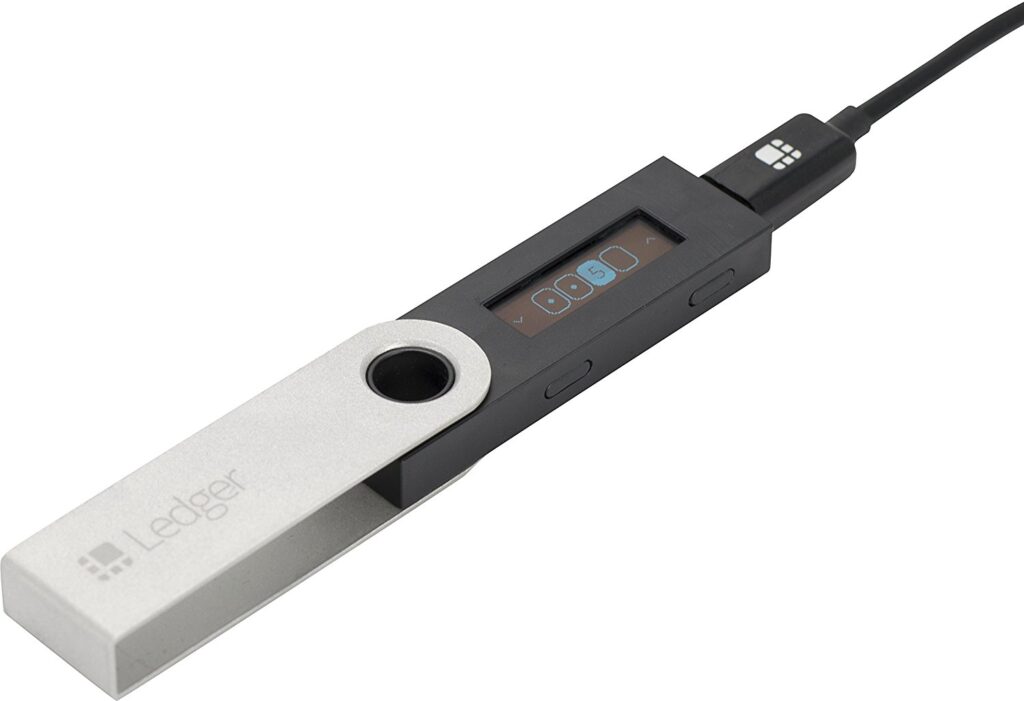

Now, as Ripple is a top 3 market cap coin, it is imperative to know how to properly store it on a hardware wallet, and the one wallet that can easily store this right now is the Ledger Nano S. You can also store it on the newly released successor to this wallet known as the Ledger Nano X, if you want a larger storage capacity and a wallet that is wirelessly capable. Let’s get to it below!
WHAT IS RIPPLE (XRP)?
Ripple is both a platform and a currency. Let me explain. Ripple itself is platform and open source protocol which is designed for quick and cheap transactions. This was “invested” as a resource for efficient, cross-border payments that is intended to be used by big banks. The Ripple platform is very very cheap and efficient and unlike bitcoin, it is designed as a payment machine and nothing more. 

XRP (the token that is represented on the ripple platform) is designed to transfer value across the Ripple platform. The intention behind this is to be able to transfer value from either cryptocurrency or fiat from peer to peer in the fastest way possible. That is it’s only function.
The other noteworthy aspect of this is, there is a predetermined amount and it is not mined or staked, like it is on POW and POS networks. In fact, there is no blockchain for this token at all. This has been the source of a lot of criticism in the ecosystem that this is not really a “crypto” currency, but rather, just a digital version of fiat.
HOW DO I BUY RIPPLE (XRP)?


You can buy ripple directly at many OTC exchanges, or other trading exchanges like Coinbase or Binance. When using Coinbase, you can link up your bank account and/or major debit card to process the transaction and if you’re not verified, it can take up to 7-10 business days to process.
If you plan on buying XRP with a credit card directly, you can use either Paxful or Changelly and use this as an OTC exchange to buy it directly (although paying with credit card will incur some extra fees). You can also go through a 2-step process and buy bitcoin with a credit card on Coinmama, and then use one of the above exchanges to swap it.
LEDGER WALLET RIPPLE: HOW DO I MOVE RIPPLE TO THE LEDGER NANO S?
- Open up Ledger Live, and make sure it’s software version is up to date.
- Head over to the Manager section on the left side bar, and search on “XRP”, then click on Install.To create an XRP wallet on your Ledger device, we first need to create an “account” for you to be able to have access to your wallet’s XRP address.


- Click on the rounded + symbol on the left portion of the Ledger Live app to add an account.


- Type in “xrp” on the search bar to easily find XRP on the list, then click on “Continue“.


- Open the XRP app on your Ledger device, then click on “Continue“.


- Wait for Ledger Live to synchronize.
- Choose a name for your wallet. For this example, we’re just going to name our wallet “My XRP Wallet“.
- Tick the blue checkbox , then click on “Add account“.


- Account successfully added!Click on “Add more” if you want to create more XRP wallets, or if you want to head over to moving your funds to your XRP wallet, just click on the small x on the top right corner of this popup.


- Your XRP wallet is now ready. Simply click on the XRP wallet you made on the “Accounts” section on the left, then click on the blue “Receive” button.


- Click on “Continue“.
- Click on “Verify“.
- For security purposes, check if the same wallet address is being shown on the Ledger Live app, and the address shown on your physical Ledger device.If everything’s fine, you can now copy the wallet address shown on Ledger Live, and you can now use that address to move your funds from other XRP wallets, or from the exchange you’re using.


- Click on the rounded + symbol on the left portion of the Ledger Live app to add an account.
WHAT ABOUT THE NEW LEDGER NANO X?
The Ledger Nano X has the same process as above for adding it to your hardware wallet using Ledger Live, the only difference is it is primarily done via the mobile app. You can still plug this device in and manage this the same way as the Ledger Nano S, however, it is able to connect to the app and manage this wirelessly, which is the major advantage.
CONCLUSION
Bottom line, if you’re in the market to acquire this coin, you will absolutely need to store it on a Ledger device. Keeping all your private keys (of any coin) on a trusted hardware wallet is imperative. Period. I will say that with the Ledger Nano S specifically, is the cheapest and is the best entry level hardware wallet if you want to store ripple at only $59. The one caveat is that you can only store 3 or 4 different coins on the app at once, that’s it. If you plan to grow your portfolio, you may want to spring for the extra money and go for the Ledger Nano X, which can hold up to 100 coins or “apps” at once. I will leave the full review of the Ledger Nano S here.
What do you think? Is there a better offline wallet to store your XRP? Let me know in the comments below!
Cheers,
The Crypto Renegade
NOTE: This post may contain affiliate links. This adds no cost to you but it helps me focus on giving as much value as possible in every single post by being compensated for recommending products that help people succeed.
- ‹ Previous
- 1
- 2
- 3
- Next ›


